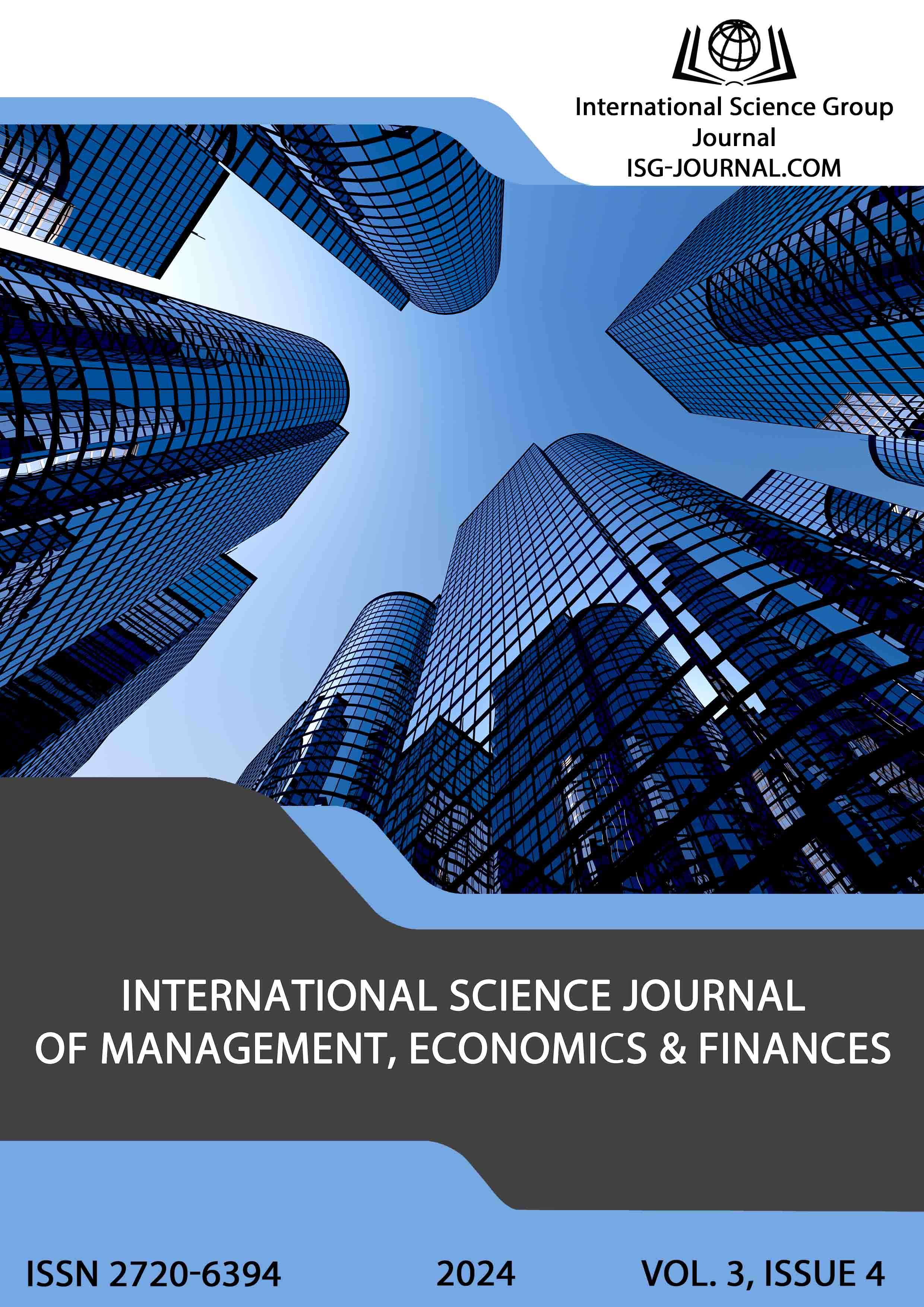Competitiveness of Ukraine: essence and main factors
DOI:
https://doi.org/10.46299/j.isjmef.20240304.07Keywords:
competitiveness of Ukraine, institutional reform, infrastructure reconstruction, innovation reform, education, social capitalAbstract
The article analyzes the state of Ukraine's competitiveness, examines the factors that affect productivity and identifies the main areas of necessary intervention and reforms at various levels to increase the stability of the national economy against the background of global competitive challenges. It was determined that the main factors of productivity are the following determinants: innovations, education, market efficiency, infrastructure, institutions. The conducted comparative analysis made it possible to determine the level of competitiveness of Ukraine in relation to the countries of the world, taking into account the peculiarities of the sectoral structure of the GDP of our country. It is noted that currently, during the full-scale invasion of Russia, significant losses have been recorded for each factor. To assess the state of innovativeness of Ukraine, an analysis of the dynamics of the Global Innovation Index was carried out, thanks to which it was found that the obstacles on the way to increasing innovativeness are low operational stability for business, problems with the rule of law, backward infrastructure, problems with access to credit resources. Among the main problems in education, the following were noted: insufficient flexibility, the proposed knowledge is too theoretical in nature, educational institutions lack modern equipment. Along with this, there are concerns about outdated teaching methods, low motivation of teachers, lack of practical knowledge in the school curriculum and its general overload. Market efficiency cannot demonstrate positive dynamics primarily due to the monopolization of commodity markets in the country. Also, one of the factors of high efficiency is the rule of law, the branch of which is currently quite corrupt in Ukraine. As for infrastructure, the huge losses due to destroyed and damaged objects as a result of Russian aggression are supplemented by the problem of a high degree of wear and tear of production and non-production assets. After detailing the problem of institutional development, it was determined that in Ukraine there is an acute situation with social capital (the indicator assesses social cohesion and involvement, public and family networks, participation in political life, trust in state authorities), protection of property rights, quality of accounting standards and audit. The analysis also showed fairly low positions in world rankings and alternative indices, such as: corruption perception index, economic freedom index, political freedom index, ease of doing business index. Further research into possible ways of synergistic development of the above-mentioned determinants is proposed.References
Zaluzhnyi, V. (2023). Modern positional warfare and how to win in it. URL: https://infographics.economist.com/2023/ExternalContent/ZALUZHNYI_FULL_VERSION.pdf
Porter, M. (1990). The Competitive Advantage of Nations. URL: https://economie.ens.psl.eu/IMG/pdf/porter_1990_-_the_competitive_advantage_of_nations.pdf
Harvard Business School: website. URL: https://www.isc.hbs.edu/competitiveness-economic-development/Pages/default.aspx
International Institute for Management Development (IMD): website. URL: https://www.imd.org/centers/wcc/world-competitiveness-center/rankings/world-competitiveness-ranking/
Жаліло, Я. А. (2005). Конкурентоспроможність економіки України в умовах глобалізації: монографія. Національний інститут стратегічних досліджень. К.: Знання України. 388 с
Економічна енциклопедія. Т. 2. Редкол.: С. В. Мочерний. (2000). К.: Академія. 814 с.
Porter, M., Sachs, J., Warner, A (2000). Executive Summary: Current Competitiveness and Growth Competitiveness. The Global Competitiveness Report 2000. Oxford: Oxford University Press.
Король, І. В. (2018). Управління конкурентоспроможністю вітчизняної економіки: монографія. МОН України, Уманський державний пед. ун-т імені Павла Тичини. Умань: Візаві. 202 с.URL: https://dspace.udpu.edu.ua/handle/6789/9803
Мельник, О. М. (2019). Ресурси підприємства: концептуальні аспекти системи управління в умовах стійкого розвитку. Науковий вісник Ужгородського національного університету. Серія: Міжнародні економічні відносини та світове господарство, (23 (2)), 17-22. URL: http://www.visnyk-econom.uzhnu.uz.ua/archive/23_2_2019ua/5.pdf
Близнюк, В. В. (2005). Людський капітал як фактор економічного розвитку. Економіка і прогнозування, (2), 64-74. URL: http://eip.org.ua/docs/EP_05_2_64_uk.pdf
Kim,Y. E., Loayza, N, V. (2019). Productivity Growth: Patterns and Determinants Across the World. URL: https://papers.ssrn.com/sol3/papers.cfm?abstract_id=3386434
Kenneth B. Kahn (2018). Understanding innovation. Business Horizons. 61(3), 453-460. URL: https://www.sciencedirect.com/science/article/abs/pii/S0007681318300119
Malik, S. (2023). Macroeconomic determinants of innovation: Evidence from Asian countries. Global Business Review, 24(1), 137-151.
Global Innovation Index. World Intellectual Property Organization (WIPO). URL: https://www.wipo.int/global_innovation_index/en/?gad_source=1&gclid=Cj0KCQiA3uGqBhDdARIsAFeJ5r3aSjy_0uJ-OFXRcArjIvbxqdUlBUwZHcfN2Jr1CJ36wsdw211V8CgaAjGjEALw_wcB
OECD. URL: https://www.oecd.org/pisa/
Фонд Демократичні ініціативи імені Ілька Кучеріва (2021). Пояснити 30%: Як українці оцінюють освіту та вступ в умовах пандемії. URL: https://dif.org.ua/article/poyasniti-30-yak-ukraintsi-otsinyuyut-osvitu-ta-vstup-v-umovakh-pandemii
Friedman, O., Trines S. (2018). Education in Ukraine. WENR. URL: https://wenr.wes.org/2019/06/education-in-ukraine
Kahkonen, S. (2018). Why Ukraine’s Education System is Not Sustainable. The World Bank. URL: https://www.worldbank.org/en/news/opinion/2018/09/12/why-ukraines-education-system-is-not-sustainable
Global Competitiveness Report 2019. World Economic Forum. URL: https://www.weforum.org/publications/how-to-end-a-decade-of-lost-productivity-growth/
Антимонопольний комітет України. URL: https://amcu.gov.ua/
Звіт про прямі збитки інфраструктури від руйнувань внаслідок військової агресії росії проти України за рік від початку повномасштабного вторгнення. KSE. URL: https://kse.ua/wp-content/uploads/2023/03/UKR_Feb23_FINAL_Damages-Report-1.pdf
За рік повномасштабної війни росія завдала збитків інфраструктурі України на майже $144 млрд. KSE. URL: https://kse.ua/ua/about-the-school/news/za-rik-povnomasshtabnoyi-viyni-rosiya-zavdala-zbitkiv-infrastrukturi-ukrayini-na-mayzhe-144-mlrd/
Прямі збитки, нанесені інфраструктурі України в ході війни, складають майже $63 млрд. Загальні втрати економіки $543-600 млрд. KSE. URL: https://kse.ua/ua/about-the-school/news/zbitki-naneseni-infrastrukturi-ukrayini-v-hodi-viyni-skladayut-mayzhe-63-mlrd/
Transparency international. URL: https://www.transparency.org/
Index of economic freedom. URL: https://www.heritage.org/index
Expanding Freedom and Democracy. Freedom house. URL: https://freedomhouse.org/
The World Bank. URL: https://www.worldbank.org/en/home
Downloads
Published
How to Cite
Issue
Section
License
Copyright (c) 2024 Oleksandr Zadoia, Alisa Mahdich, Artem Novikov

This work is licensed under a Creative Commons Attribution 4.0 International License.






